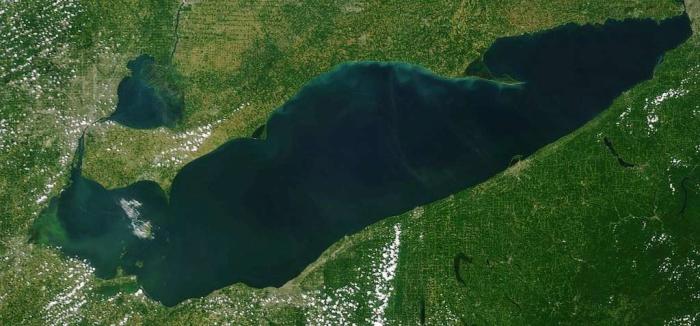
Lake Erie is the second smallest of the Great Lakes, and the shallowest. As the shallowest, it’s also the only Great Lake that freezes over in the winter. Lake Erie is the closest Great Lake to us here in Euclid! You may have even been swimming in it before or played in the sand on its shores. It’s so big, it touches not only Ohio, but also Pennsylvania, Michigan, New York, and Canada!
Lake Erie has been around for thousands of years, and it was formed by giant glaciers moving across this part of North America. The glaciers pushed away rock and dirt, leaving behind a giant crater that filled with water. People have been relying on Lake Erie ever since, as a source of fresh water and fast travel.
Although small, Lake Erie can make some massive waves that are a danger to sailors who cross the lake. These waves are called seiche waves (pronounced “saysh”), and their force is similar to a tidal wave at sea. Many ships have sunk in Lake Erie, including the Walk-in-the-Water in 1821, which was the first ship on the Great Lakes to combine steam power with sails.
These articles are written by library staff using library resources such as books, eBooks, and databases. Information can vary from book to book and database to database. Tickle Your Brain is meant to be a jumping off point for starting conversations about new topics of learning. It is not to be used as an authoritative resource.
 ,
, 
- Lake Erie is connected to another Great Lake, Lake Ontario, by the Niagara River, which is where the famous Niagara Fall is.
- During the war of 1812, there was a major battle that took place on Lake Erie between the United States and Great Britain. This is one of the few naval battles that took place on freshwater (most big naval battles take place on the ocean, which is salt water).
- Lake Erie was once the most polluted of the Great Lakes, because its shallow waters made it more susceptible to pollution. However, in 1972, the government passed laws to help control pollution and clean up Lake Erie.
- Lake Erie by Ann Armbruster
- The Great Lakes by Janet Piehl
- The Great Lakes: Our Freshwater Treasure by Barb Rosenstock
